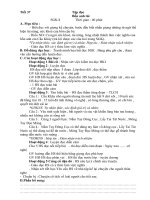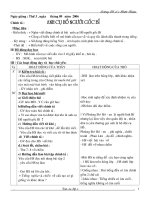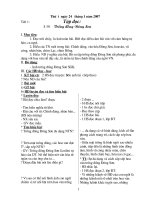Bài giảng Real-time Systems: Week 4: Basic concepts of scheduling
Bạn đang xem bản rút gọn của tài liệu. Xem và tải ngay bản đầy đủ của tài liệu tại đây (676.18 KB, 52 trang )
Real-time Systems
Week 4:
Basic concepts of scheduling
Ngo Lam Trung
Dept. of Computer Engineering
NLT, SoICT, 2015
Contents
Introduction
of scheduling
Constraints
of real-time tasks
Classification
Scheduling
of scheduling algorithms
anomalies
NLT, SoICT, 2015
Introduction
Why
do we need scheduling?
There are always more tasks than processors.
Multiple tasks run concurrently on uniprocessor
system.
Scheduling
policy: the criterion to assign the
CPU time to concurrent tasks
Scheduling
algorithm: the set of rules that
determines the order in which tasks are
executed
What is the main difference between scheduling in
RTOS and GPOS?
NLT, SoICT, 2015
An illustration of scheduling (1)
All activated tasks enters “ready queue” at first.
The scheduler selects one task in the Ready queue according to the
tasks’ priorities allocated based on the scheduling algorithm.
The selected task is dispatched and becomes in “running” state.
After the selected task is completed, it is removed from the Ready
queue.
Scheduler
task
activate
Start/
dispatched
Ready queue
terminate
running
preempted
released
Wait queues
Wait/blocked
NLT, SoICT, 2015
Preemption
The running task can be interrupted at any point, so that a
more important task that arrives can immediately gain the
processor.
The to-be-preempted task is interrupted and inserted to
the ready queue, while CPU is assigned to the most
important ready task which just arrived.
Preemption is the solution for dynamic OS.
Why preemption is needed in real-time systems?
Exception handling of a task
Treating with different criticalities of tasks, permits to anticipate
the execution of the most critical activities
Efficient scheduling to improve system responsiveness
FreeRTOS
NLT, SoICT, 2015
Notation of scheduling (1)
J
= {J1,…,Jn}
:R+N
A set of tasks
A schedule
A function mapping from time to task to assign task to
CPU
If (t)=i for t[t1,t2), task Ji is executed during time
duration [t1,t2).
If (t)=0, the CPU is idle.
Simple
translation
CPU time is divided in to time slices [t1,t2)
During a time slice (t)=const, representing the task
that is executed
NLT, SoICT, 2015
Notation
of
scheduling(2)
Notation of scheduling (2)
Idle
J1
J2
J3
3
idle
(t)
2
1
A time slice
t1
t2
t3
t4
Context switching are performed at these times
NLT, SoICT, 2015
Notation of scheduling (3)
Preemptive
A schedule in which the running task can be arbitrarily
suspended at any time, to assign the CPU to another
task
Feasible
schedule
schedule
A schedule that all tasks can be completed according to
a set of specified constraints
Schedulable
set of tasks
A set of tasks that has at least one feasible schedule by
some scheduling algorithm
NLT, SoICT, 2015
Example of preemptive schedule
J1
t
J2
t
J3
t
(t)
3
2
1
t
NLT, SoICT, 2015
Types of task constraints
Timing
constraints
Precedence
Resource
constraints
constraints
NLT, SoICT, 2015
Timing constraints
Timing
constraints:
Constraints on execution time, is the time that must
be meet in order to achieve the desired behavior.
Typical constraint: deadline
- Relative deadline: deadline is specified with respect to the
arrival time
- Absolute deadline: deadline is specified with respect to time
zero.
Classification
of real-time tasks
Hard : completion after deadline can cause
catastrophic consequence
Soft : missing deadline decreases the performance of
the system but does not jeopardize its correct
behavior
NLT, SoICT, 2015
Task parameters(1)
Li
Lateness
Ci
time
fi
Di relative deadline
Ci Execution
time
ai
arrival time
fi
finishing
time
Si
start time
Xi Laxity
di
absolute
deadline
time
NLT, SoICT, 2015
Task parameters(2)
Other task parameters
Response time: different between the finishing time and
the request time Ri = fi - ri
Criticality: Hard or Soft
Value vi: relative importance of task with respect to the
other tasks
Lateness: the delay of a task completion with respect to its
deadline Li = fi –di
Tardiness or Exceeding time: Ei = max(0,Li) is the time a
task stays active after its deadline.
Laxity or Slack time Xi = di – ai – Ci is the maximum time a
task can be delayed on its activation to complete within its
deadline
NLT, SoICT, 2015
Task parameters(3)
Regularity
of task activation
Periodic tasks: infinite sequence of identical activities
(jobs) activated at constant rate
Aperiodic: infinite sequence of identical activities
(jobs) with irregular activation
Sporadic: aperiodic tasks where consecutive
activation are separated by some minimum interarrival time
NLT, SoICT, 2015
Periodic task and aperiodic task
NLT, SoICT, 2015
Precedence constraints
Tasks
can have precedence constraint:
A task has to be executed after another task is completed
Notation:
Precedence relations are described by a directed acyclic
graph G.
: task Ja is a predecessor of task Jb
: task Ja is an immediate predecessor of Jb
NLT, SoICT, 2015
An example of precedence relations
To be executed
earlier
J1
J2
To be executed
later
J4
J3
J5
NLT, SoICT, 2015
An example of deriving precedence relations
Motors
and
encoders
CPU
board
Motor
drivers
Sensors
NLT, SoICT, 2015
Tasks
J2
J1
J3
J4
J5
J1: read sensors input
J4: control left wheel
J2: read encoder values
J5: control right wheel
J3: calculate control commands
NLT, SoICT, 2015
Resource constraints
Resource
Any software structure that can be used by the process
to advance its execution
Ex: data structure, a set of variables, main memory area,
a file, a piece of program, a set of registers of a
peripheral device
Private
A resource dedicated to a particular process
Shared
resource:
resource:
A resource that can be used by more tasks
NLT, SoICT, 2015
Shared resource & critical section
Many
shared resources do not allow
simultaneous access
require mutual exclusion
Critical
section
A piece of code under mutual exclusion constraints
Created by synchronization mechanism
When
tasks have resource constrains, they have
to be synchronized
NLT, SoICT, 2015
An example of mutual exclusion
Lower priority
J2
Higher priority
J1
Wait(s)
Critical section
Signal(s)
Wait(s)
Shared resource
R
Critical section
Signal(s)
Critical section is created by using the binary semaphore s
NLT, SoICT, 2015
An example of mutual exclusion
Scheduling with preemption
preempts
blocked
Higher priority
J1
Lower priority
J2
Locks resource
normal execution
Unlocks resource
critical section
NLT, SoICT, 2015
Waiting state caused by resource constraint
scheduling
Termination
activation
RUN
READY
preemption
Wait on busy
resource
Signal free
resource
WAITING
NLT, SoICT, 2015
Definition of scheduling problems
Given
J = {J1,…,Jn}: A set of tasks
P = {P1,…,Pm}: A set of processors
R = {R1,…,Rr}: A set of resources
With precedence constraints and timing constraints
Scheduling
problem:
Assigning processors from P and resource from R to
tasks from J under given constraints
NLT, SoICT, 2015









